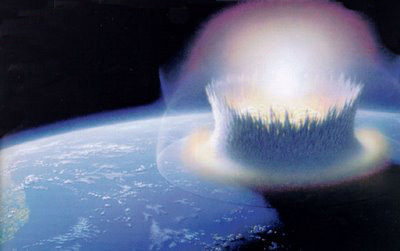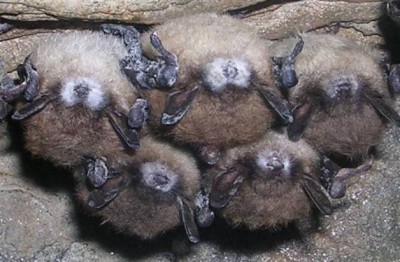29 May 2009
Welcome To The What?? The Anthropocene!
Posted by Dan Satterfield
Here in America, a house that is over 100 years old is not only rare, but considered to be quite old. A house that is over 200 years old is positively ancient and may very well be a museum! The old historic district here in Huntsville has some beautiful old homes. Some dating from before 1820. If I ever win the lottery, I will own one too. (It might help if I bought a ticket though!).
In Europe, old has a different meaning. I once stayed at a bed and breakfast in Edinburgh and asked the owner if the building was as old as it looked. She replied, no, this is the new part of town. This house was built in 1769! Old is no doubt a relative concept.
To Geologists, old has an entirely different meaning. Much like “far away” to Astronomers. Geology students sometimes have a tough time getting their head around the concept of deep time. The Earth has celebrated it’s millionth birthday party, 4,500 times!
Here is a fun way to imagine it. Hold your arms out as far as you can, and let that length be equal to those 4,500 million years. The Earth formed at the tip of your fingernails on your left hand. The Jurassic period, when dinosaurs ruled, is a small part of your RIGHT arm near your wrist. The first species we would call “Humans” evolved just a couple of million years ago and is the very tip of your fingernail, on your longest right finger.
Geologists have developed an age chart of the Earth that has been revised over the decades to make sense of this enormous amount of time. Most people are familiar with the names of some of these divisions. The movie Jurassic Park for instance. You likely have seen this chart in a text book or online.
Over this planet’s long history there seems to have been five times when life was nearly wiped out. The greatest of these mass extinctions is sometimes called the great Permian dying. At the end of the Permian period, nearly 90% of Earth species disappeared. If you ever went fossil hunting and found a trilobite, it was from the Permian or before. They were one of the casualties of this great extinction. What caused it? Evidence points to volcanoes, but it’s still uncertain.
This paved the way for the dinosaurs which ruled for over 150 million years until 65 million years ago, when they too met their end. The extinction of the dinosaurs along with many other species is likely solved.. It was probably a meteorite. Why are geologists so certain? The puzzle pieces fit together (See my last post). (There are still some doubters, and you should know the Science is not completely settled on this)
A Geologist in Italy was looking at a stack of rocks that spanned the end of the Cretaceous and the beginning of the Tertiary periods. He noticed a layer of an unusual mineral and it turned out to have a very high concentration of iridium. Iridium is rare on earth and it’s only formed in extreme pressures and temps. When it was proposed that a meteor wiped out the dinosaurs, many geologists laughed. They aren’t laughing now. The crater was found deep under the Gulf of Mexico mud, and it’s been dated to exactly 65 million years old. The iridium shows up across the planet in rocks 65 million years old. There is now a growing body of independent evidence that something rocked our world 65.5 million years ago. (+/- 300k years)From NASA
The end of the dinosaurs allowed a little species called Mammals to thrive, and thrive they have, Humans now inhabit every corner of this planet and have controlled it’s rivers, changed it’s atmosphere markedly, by doubling the Methane and and increasing the Carbon Dioxide significantly in just 200 years. Just a blink of the eye in Geologic time. Cities and agriculture have increased the erosion rates dramatically. The oceans are now noticeably more acidic, and most of all there seems to be another mass extinction underway. We know for certain what is causing this 6th great extinction. One of those Mammals that thrived after the “Terrible Lizards” were wiped out. It’s Homo Sapiens Sapiens. US.
Elizabeth Kolbert has a superb article in the New Yorker about this great extinction. It’s long, but you should really read it. Just this week, many caves here in the Southeast have been closed. They are trying to stop White Nose Syndrome. It’s killing bats rapidly. Just like the frogs, they are disappearing. Kolbert explains it well. If you read one long article this month-make it this one.
The question is this. Will Geologists of the far future look at the rocks of earth from our time, and say, “something changed there”. The answer seems to be a resounding yes. If so, where do you draw the line? Most of man’s affect on Earth starts showing up at the beginning of the industrial revolution.
In a paper published last year a group of Geologists, led by Jan Zalasiewic, supported strongly the idea, put forth in 2000 by Nobel Prize winner Paul Crutzen, that we are no longer living in the Holocene. The Holocene began 11,000 years ago, when we finished coming out of the last ice age (Pleistocene). Crutzen calls this new period the Anthropocene. Andy Revkin of the New York Times (He write an excellent blog), first suggested something similar called the Anthrocene as early as 1992.
At the end of the Permian, 96% of all marine species died off. 70% of land vertebrates like us. I can’t help but wonder what the Anthropocence will bring. Unlike the other 5 extinctions, this one is in our hands.
Sources: 1. Unweaving the Rainbow- Richard Dawkins (Imagining deep time) 2. The 6th Great Extinction Eliz. Kolbert- New Yorker May 25, 2009. 3. Are We Now Living in the Anthropocene Jan Zalasiewic et.al GSA Today Feb. 2008. Evolution of the Earth by Dott and Prothero. NASA and NY Dep. Cons. for images. International Commision on Stratigraphy (ICS). wiki article on Anthropocene and Paul Crutzen.





 Dan Satterfield has worked as an on air meteorologist for 32 years in Oklahoma, Florida and Alabama. Forecasting weather is Dan's job, but all of Earth Science is his passion. This journal is where Dan writes about things he has too little time for on air. Dan blogs about peer-reviewed Earth science for Junior High level audiences and up.
Dan Satterfield has worked as an on air meteorologist for 32 years in Oklahoma, Florida and Alabama. Forecasting weather is Dan's job, but all of Earth Science is his passion. This journal is where Dan writes about things he has too little time for on air. Dan blogs about peer-reviewed Earth science for Junior High level audiences and up.
The book “Under a Green Sky” by Peter Ward explores extinctions in some detail and speculates on the features of the next one. It’s good reading.
Thanks Brian,
I have added it to next months book allowance!
DS
Well, this is how I justify to myself spending money on the lottery: My chances are 100% better than those people who never play!!!
Excellent post. I am a little embarrassed I had been thinking HOLOCENE up until today! Like those people who can’t recite their phone numbers off the top of their heads, I had been claiming the wrong epoch!!!
Thanks for writing about this. There’s a mass of solid tech info on the internet. You’ve got a lot of that info here on your website. I’m impressed – I try to keep a couple blogs somewhat up-to-date, but it’s a struggle sometimes. You’ve done a big job with this one. How do you do it?
May I suggest that “Hold your arms out…” be written as “Hold your arms apart…”. A small thing, but I believe this is what is said more for your meaning.
No offense intended. Thanks
I agree. Better way to say it for sure.